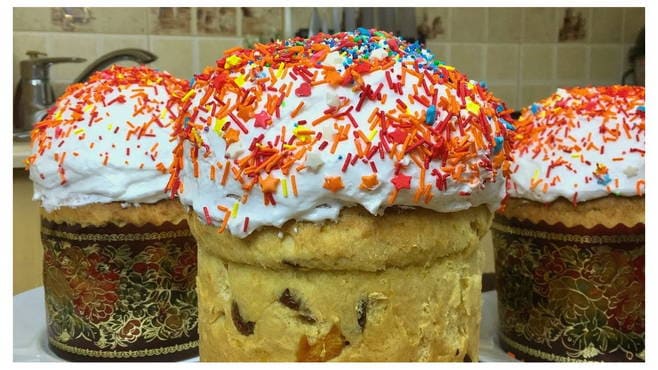Easter cake with cognac
0
2278
Kitchen
Russian
Calorie content
374.8 kcal
Portions
6 port.
Cooking time
3 hours
Proteins *
6.4 gr.
Fats *
18 gr.
Carbohydrates*
43.8 g
Easter cake prepared with the addition of cognac has a very interesting aroma and does not get stale for longer. So that the alcoholic accent is pronounced, not unobtrusive, we first soak the raisins in cognac. The pulp of the dried fruit will retain the aroma and cognac bitterness, which, against the background of a delicate sweet dough, will delicately contrast, but will not completely overshadow the taste of baked goods. The preparation of the dough for such a cake is a classic, sponge way. The recipe is designed to use both fresh and dry yeast.
Ingredients
Cooking process
We prepare products for making Easter cake. Separate the yolks from the proteins. Cut the butter into small pieces and leave at room temperature so that it has time to soften. We wash the raisins in hot water, dry them, place them in a small bowl and fill them with cognac. While the dough is being prepared, there will be enough time for the dried fruit to soften and absorb the aroma and taste of alcohol. We heat the milk until warm.
To prepare the dough, pour warm milk into a large bowl and add yeast. Stir the mixture with a whisk so that the yeast is completely dissolved in the liquid. Add half a glass of sifted flour from the total specified amount, stir with a whisk until smooth and leave in a warm place for thirty to forty minutes. During this time, the volume of the dough should increase significantly, and foam will appear on its surface. While the dough is activated, rub softened butter with granulated sugar with a spoon in a separate container. Add the yolks one at a time, kneading thoroughly after each addition. Put salt and vanillin, stir. Sift the flour and add half to the butter-yolk mass, stir until smooth. After that, pour the dough into the dough, mix. Pour in the rest of the flour and knead the soft dough. We tighten the bowl with the dough with cling film and put it in a warm place for an hour and a half. After raising the dough, add raisins soaked in cognac (we do not squeeze raisins) and candied fruits, gently knead with your hands. Leave in a warm place for another hour or two, until the dough doubles.
Preparing baking dishes. Special paper or silicone molds do not require lubrication. Molds made of other material should be greased with a small amount of vegetable oil. We spread the dough in forms, filling them no more than a third, since the volume of the dough will increase during baking. When laying out the dough, we try to make sure that the pieces of candied fruits and raisins are immersed inside and do not lie on the surface, since during baking they can burn and spoil the taste of the cake.
We leave the completed forms for half an hour - the dough will increase a little more and fill the volume of the form.Preheat the oven to 180 degrees. Place the cakes on the wire rack and place them on the middle level. We bake for 25-35 minutes, until the products noticeably increase in volume and the surface is covered with a golden brown crust. If in doubt about the readiness of the dough, check it with a wooden skewer, sticking it into the middle of the cake. If the sticks come out dry, the cake is ready.
Bon Appetit!







